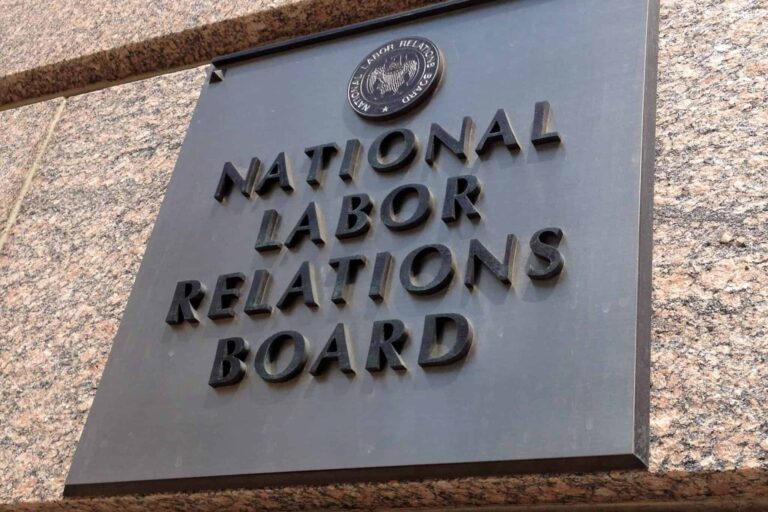
Andrew Strom has been a union lawyer for more than 25 years. He is an Associate General Counsel of Service Employees International Union, Local 32BJ in New York, NY. He is the author of Caught in a Vicious Cycle: A Weak Labor Movement Emboldens the Ruling Class, 16 U.St. Thomas L.J. 19 (2019); Boeing and the NLRB: A Sixty-Four Year-old Time Bomb Explodes, 68 National Lawyers Guild Review 109 (2011); and Rethinking the NLRB’s Approach to Union Recognition Agreements, 15 Berkeley J. Emp. &; Lab. L. 50 (1994), and has written for Dissent and Dollars and Sense. He also taught advanced legal writing at Fordham Law School. He received his J.D. magna cum laude from Harvard Law School. The views he expresses on this blog are his personal views, and should not be attributed to SEIU Local 32BJ.
If there is a silver lining in the efforts of Donald Trump’s appointees to crank out as many anti-worker decisions as possible at the National Labor Relations Board, it is that each new decision highlights the need for a fundamental overhaul of our labor laws. Buried in a footnote in a blizzard of decisions issued at the end of July, the Trump trio overruled seventy years of NLRB case law interpreting Section 8(c) of the National Labor Relations Act – a provision that states, “The expressing of any views, argument, or opinion, or the dissemination thereof, whether in written, printed, graphic, or visual form, shall not constitute or be evidence of an unfair labor practice under any of the provisions of this Act if such expression contains no threat of reprisal or force or promise of benefit.” Citing several circuit court decisions denying enforcement of NLRB orders, the Trump Board Members held that an employer’s anti-union statements (unaccompanied by threats or promises) may never be used as evidence that the employer was hostile toward its employees’ organizing efforts. Note that Section 8(c) is not limited to “views, argument, or opinion” about unions, so taken literally it would mean that the Board may not consider evidence that a supervisor had expressed the opinion that a union activist was an excellent worker in a case where the employer claimed that the activist was fired for poor work performance. While there is a more sensible way to interpret 8(c), the better course would be to remove this poorly worded provision from the NLRA.
The Trump Board’s pronouncement on Section 8(c) came in United Site Services, a case about whether an employer had illegally discriminated against returning strikers. When workers go out on an economic strike, employers generally are allowed to hire permanent replacements who do not need to be displaced when the strikers make an unconditional offer to return to work. But the NLRB has placed some restrictions on the use of permanent replacements. The Board has held that it is illegal for an employer to hire permanent replacements if the employer is “motivated by an independent unlawful purpose.”
The particular issue in the United Site Services case does not arise often, but many NLRB cases turn on whether an employer acted out of an unlawful motive. This issue comes up most often when an employer fires a union activist. Employers will rarely admit their illegal motive, so the NLRB must look to circumstantial evidence. These cases are very similar to employment discrimination cases where a worker alleges that she was fired because of her race, sex, nationality, religion, age, or disability. In any case involving discriminatory intent, to prevail you need to show some evidence that the employer harbored hostility toward the protected group, and one way to show this is by statements made by decision-makers. As the Supreme Court plurality noted in a landmark sex discrimination case, “stereotyped remarks can certainly be evidence that gender played a part.”
Think about how hard it would be to prove race or sex or age discrimination if plaintiffs were barred from introducing evidence that supervisors expressed stereotypical or bigoted views, arguments, or opinions. What if there were an employer who distributed a handbook with the following statement: “While we will abide by the law, we believe that a woman’s place is in the home and having women in the workplace makes us less efficient.” Can you imagine a court holding that it could not consider that statement in deciding a sex discrimination case against that employer? Of course not. For years, the NLRB has interpreted Section 8(c) to hold that while an employer may make anti-union statements with impunity, those statements can be a “proper and highly significant factor which may be considered in evaluating the reason for a discharge.”
In United Site Services, the Administrative Law Judge (ALJ) found that the employer had acted with an “independent unlawful purpose” when it hired permanent replacements because it was not merely trying to gain bargaining leverage or maintain operations, but rather it was trying to break the union. In reaching this conclusion, the ALJ pointed to several pieces of evidence, and part of that evidence was a statement of “Non-Union Philosophy” in the employee handbook. The statement read in full: “United Site Services will do everything in its legal power to prevent any outside third party who is potentially adversarial, such as a union from intervening or interrupting the one-on-one communications or operational freedoms that we currently enjoy with our associates.”
Predictably, the Trump appointees reversed the ALJ’s finding that the employer acted with an “independent unlawful purpose” when it hired permanent replacements. While the Board Members conceded that there was “some evidence of unlawful purpose,” it held that Section 8(c) precluded the Board from relying on the “Non-Union Philosophy” statement as evidence of the employer’s anti-union animus. While the Trump appointees overruled almost seventy years of contrary Board law, I can’t totally blame them because at least three different Circuit courts have adopted that interpretation of Section 8(c), and I’m quite certain that there are currently five Supreme Court Justices who would readily adopt that view.
The cases where circuit courts have held that Section 8(c) barred the Board from considering anti-union statements by employers demonstrate how this interpretation of 8(c) makes it hard for workers to obtain justice. In one case, a manager described an organizing effort as “like a knife in the back;” and in another, the company showed workers films depicting union violence. This is exactly the type of evidence of hostility and stereotypical views that would be used in a race or sex or age discrimination case to show discriminatory motive. And, while courts have suggested that this interpretation of Section 8(c) is required by the First Amendment, this is simply not true. The First Amendment right to make anti-union statements is no different from the First Amendment right to make racist statements. In upholding a Wisconsin statute that imposed harsher criminal penalties for defendants who select their victims on account of the victim’s race, the Supreme Court unanimously held, “[t]he First Amendment … does not prohibit the evidentiary use of speech to establish the elements of a crime or to prove motive or intent.”
If we are going to protect the right to organize, then the NLRB and the courts should not have to ignore evidence of an employer’s hostility toward unions in deciding whether the employer discriminated against workers on account of their organizing activity. If 8(c) is an obstacle to this common sense notion, then it needs to go.









Daily News & Commentary
Start your day with our roundup of the latest labor developments. See all
April 19
Alabama and Louisiana advance anti-worker legislation; Mercedes workers in Alabama set election date; VW Chattanooga election concludes today.
April 18
Disneyland performers file petition for unionization and union elections begin at Volkswagen plant in Tennessee.
April 18
In today’s Tech@Work, a regulation-of-algorithms-in-hiring blitz: Mass. AG issues advisory clarifying how state laws apply to AI decisionmaking tools; and British union TUC launches campaign for new law to regulate the use of AI at work.
April 17
Southern governors oppose UAW organizing in their states; Florida bans local heat protections for workers; Google employees occupy company offices to protest contracts with the Israeli government
April 16
EEOC publishes final regulation implementing the Pregnant Workers Fairness Act, Volkswagen workers in Tennessee gear up for a union election, and the First Circuit revives the Whole Foods case over BLM masks.
April 15
The Supreme Court ruled in favor of bakery delivery drivers in an exemption from mandatory arbitration case; A Teamsters Local ends its 18-month strike by accepting settlement payments and agreeing to dissolve